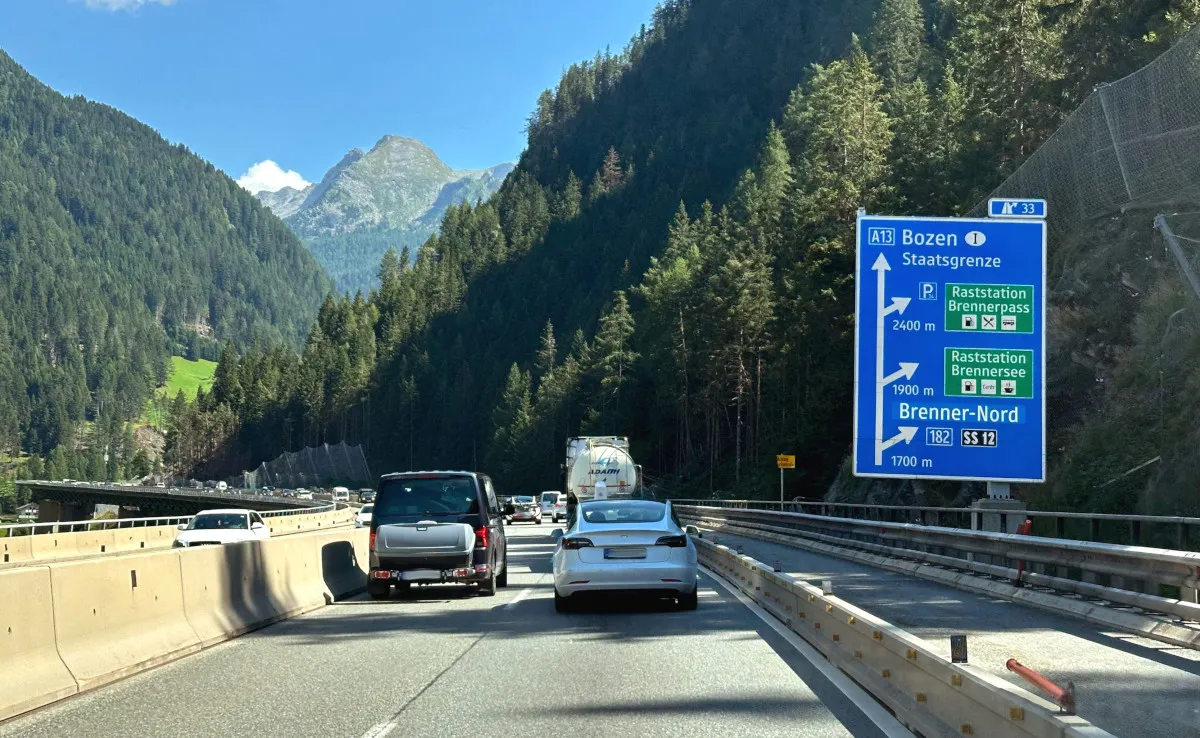The figures were revealed during the launch of a White Paper on infrastructure priorities for the Trentino–Alto Adige region, held in Trento on 23 July. Uniontrasporti, a company owned by the Italian Chamber of Commerce, estimates that the annual loss currently stands at €370 million due to limitations along the Austrian side of the Brenner corridor.
The analysis indicates a 50% reduction in motorway capacity on the Austrian side of the route, which has been further exacerbated in recent months by extraordinary maintenance work on the Lueg bridge.
Uniontrasporti Director Antonello Fontanili highlighted the strategic importance of the Brenner corridor for both trade and tourism. Of the €550 billion in annual transalpine trade between Italy and the rest of Europe, more than 29% passes through the Brenner. The share rises to 32% when considering road transport alone.
According to Confindustria Alto Adige, some 2.37 million HGVs crossed the Italian–Austrian border at the Brenner in 2024, alongside 11.55 million passenger cars, many linked to tourism flows. Trentino–Alto Adige is the second most visited tourist destination in Italy after Veneto, with 56.7 million overnight stays recorded in 2024. Bolzano ranks third among Italian destinations after Rome and Venice, while Trento ranks fourth.
The White Paper identifies the completion of the Brenner Base Tunnel (BBT), scheduled for 2032, as the top priority for businesses in the region. Other key demands include upgrading the southern access rail line from Verona to Fortezza, improving the Bolzano–Merano railway, resolving the long-standing concession issue surrounding the A22 motorway, and developing the Trento freight terminal.
Infrastructure performance indicators compiled by Uniontrasporti show that Bolzano performs slightly above the national average (index score 102.9), while Trento remains well below it (89.8).
Uniontrasporti’s analysis also points to wider concerns across all Alpine crossings. Over 176 million tonnes of goods are transported annually through these routes, underscoring the need for more efficient and sustainable logistics infrastructure. The matter has also drawn attention from CIPRA, the International Commission for the Protection of the Alps, which brings together over 100 associations.
Calls for a swift resolution of the Brenner motorway issue have intensified in recent days, following a bilateral meeting between the Italian and Austrian governments. While digital traffic management tools are available, Uniontrasporti stresses that they cannot eliminate the disruptions and delays inherent to road freight transport.
In case you missed it: British haulier with 158 years of history destroyed by cyberattack
Delays hit Brenner Base Tunnel access routes
While the Brenner Base Tunnel is still set to open in 2032, crucial northern access routes are falling behind. Austria’s ÖBB has postponed the four-track upgrade of the Lower Inn Valley line to 2039 due to federal budget cuts and slow progress in Germany. ÖBB warns the tunnel’s full freight-shifting potential cannot be realised without these links.
Tyrol’s Transport Minister called the delay “very painful”, citing negative impacts on both freight and regional rail. In Germany, Deutsche Bahn’s preferred “Purple” route has yet to be approved, with political disagreements and recent elections delaying a Bundestag decision. The tunnel, approved in 2004, is expected to cut Munich–Verona train times from five hours to three.
Further details about the tunnel: Brenner Base Tunnel: Cost-cutting measures and political blockades slow down expansion
Digital truck slot system back under discussion
In the meantime, Austria, Bavaria and Italy are revisiting plans for a digital slot booking system for trucks on the Brenner corridor, aimed at easing congestion and reducing tensions over freight transit. The scheme, first proposed in 2023, would require hauliers to book 30-minute slots at least 24 hours in advance before crossing the Alpine route.
The plan was revived on 10 July 2025 by Austrian Chancellor Christian Stocker and Bavarian Prime Minister Markus Söder, who stressed the need for trilateral agreement and EU legal compliance. Italian Prime Minister Giorgia Meloni called the idea “pragmatic” but said further evaluation is needed.
A technical group from the three countries will assess feasibility, though Italy has yet to formally commit and continues its legal case against Austria at the European Court of Justice. Austria’s Asfinag has developed a prototype and control centre in Innsbruck, ready for a pilot on the Verona–Munich corridor.
Reactions are mixed: Italian hauliers see the system as a disguised quota, while Tyrolean activists fear it could boost traffic unless capped. A trilateral meeting is set for September, with a political decision possibly following at the EU Transport Council in December.
Read our in-depth article on the subject: Brenner truck slot plan back on the table









